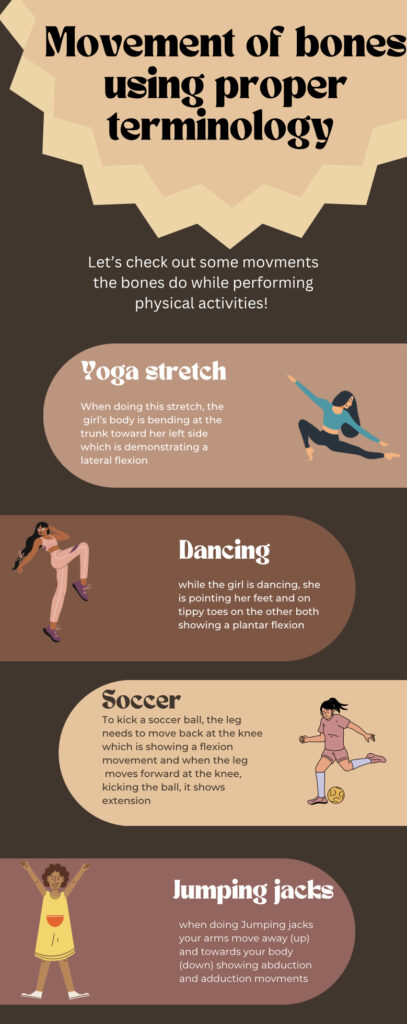The objective topic I chose is “describe the movement of bones using proper terminology.” My project art piece is demonstrating the types of movements adolescents do when engaging in physical activities or sports.
Bone health is extremely important, especially in children because childhood is when the maximal peak bone mass should be attained. A study done by Nguyen (2018), called School Based Exercise Interventions Effectively Increase Bone Mineralization in Children and Adolescence goes into depth on deciding if schools exercise implementations improve bone mineralization. The researchers found 17 studies that focused on different interventions which utilize high impact/high intensity weight bearing physical activity specifically designed to improve bone health. Some of the exercises performed include running, high impact jumping, sports games, dancing, resistance exercises, etc. with each of them varying in intensity and duration. The results showed that 15/17 of those studies had an increase bone mineral density and 2/17 did not find any significant increases. However, Nguyen (2018), did find that those two studies had results showing a significant increase in bone structural strength. One important thing to mention is that these exercises are not long. Short periods of time, three times a week, are sufficient to improve bone mineral density if the intensity of the exercise is high enough. One of the studies in this article mentions that just 10 minutes of moderate to vigorous intensity weight bearing physical activity can significantly increase bone strength in adolescence (Nguyen, 2018).
Other forms of physical activity like yoga are said to improve physical and mental health. A study done by Mandal et al. (2022) called Differences in Skeletal Growth Pattern of Yoga Practicing Adolescent Girls: a Cross Sectional Study, focuses on the effect that yoga has on adolescent girls. Their research explores the differences between girls aged 4-15 years old who do yoga and girls who do not by comparing height, sitting height, and leg length. The girls that participate in yoga perform poses that are age and intensity appropriate, while those that do not are involved in other sports or activities that vary in intensity (Mandal et al., 2022). The results show that between the ages 10 to 12, the adolescent girls that do yoga have a significant decrease in height, sitting height, and leg length. Mandal et al. (2022) states that tension, compression, mechanical forces etc. play important roles in height. This study explains that the stress on the skeletal system caused by intense yoga is why height in adolescence was hindered.
The World Health Organization (WHO) has an article called “WHO guidelines on physical activity and sedentary behavior.” In this piece, it explains how vigorous intensity aerobic exercise should be incorporated at a minimum of 3x a week. Their evidence shows that having an increased physical activity improves musculoskeletal fitness in children and adolescence. The WHO also goes on to say that children and adolescents who are more active than others have a higher bone mineral density, bone strength, and bone mass.
Overall, exercise plays a huge role on bone health in adolescence. My research shows that the more physical activity children have, the higher bone mineral density and in some cases the higher bone strength they have. I also found that yoga decreases height in girls between 10-12 years old due to intense exercise. Exercise has positive and possible adverse effects on bone health in adolescence.
References
Nguyen, V. (2018). School-based Exercise Interventions Effectively Increase Bone Mineralization in Children and Adolescents. Osteoporosis and Sarcopenia, 4(2), e39-46.
https://www-sciencedirect-com.uaf.idm.oclc.org/science/article/pii/S2405525518300141
Mandal, D., Ray, U., Ghosh, P. (2022). Differences in Skeletal Growth Pattern of Yoga Practicing Adolescent Girls: A Cross-Sectional Study. Journal of Ayurveda and Integrative Medicine, 13(2).
https://www-sciencedirect-com.uaf.idm.oclc.org/science/article/pii/S0975947622000092
World Health Organization (2021). WHO Guidelines on Physical Activity and Sedentary Behavior. e25-28.
https://www.who.int/publications/i/item/9789240014886

